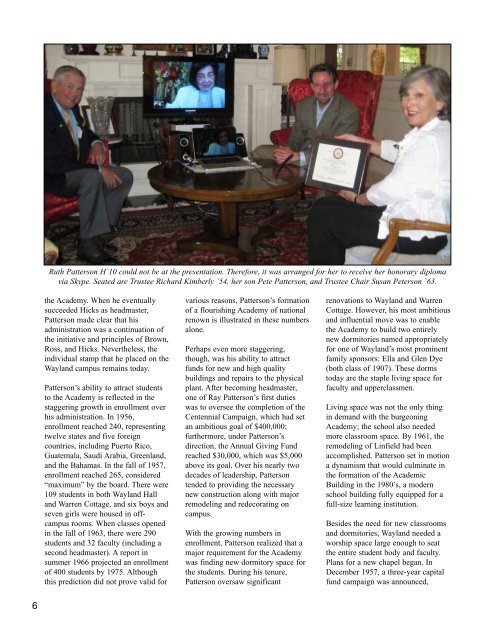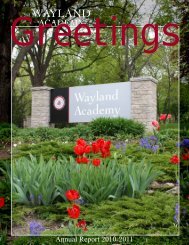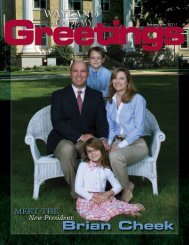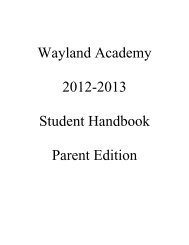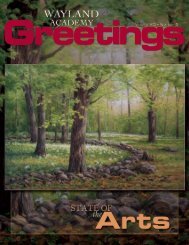2009-2010 Annual Report - Wayland Academy
2009-2010 Annual Report - Wayland Academy
2009-2010 Annual Report - Wayland Academy
Create successful ePaper yourself
Turn your PDF publications into a flip-book with our unique Google optimized e-Paper software.
6<br />
Ruth Patterson H`10 could not be at the presentation. Therefore, it was arranged for her to receive her honorary diploma<br />
via Skype. Seated are Trustee Richard Kimberly `54, her son Pete Patterson, and Trustee Chair Susan Peterson `63.<br />
the <strong>Academy</strong>. When he eventually<br />
succeeded Hicks as headmaster,<br />
Patterson made clear that his<br />
administration was a continuation of<br />
the initiative and principles of Brown,<br />
Ross, and Hicks. Nevertheless, the<br />
individual stamp that he placed on the<br />
<strong>Wayland</strong> campus remains today.<br />
Patterson’s ability to attract students<br />
to the <strong>Academy</strong> is reflected in the<br />
staggering growth in enrollment over<br />
his administration. In 1956,<br />
enrollment reached 240, representing<br />
twelve states and five foreign<br />
countries, including Puerto Rico,<br />
Guatemala, Saudi Arabia, Greenland,<br />
and the Bahamas. In the fall of 1957,<br />
enrollment reached 265, considered<br />
“maximum” by the board. There were<br />
109 students in both <strong>Wayland</strong> Hall<br />
and Warren Cottage, and six boys and<br />
seven girls were housed in offcampus<br />
rooms. When classes opened<br />
in the fall of 1963, there were 290<br />
students and 32 faculty (including a<br />
second headmaster). A report in<br />
summer 1966 projected an enrollment<br />
of 400 students by 1975. Although<br />
this prediction did not prove valid for<br />
various reasons, Patterson’s formation<br />
of a flourishing <strong>Academy</strong> of national<br />
renown is illustrated in these numbers<br />
alone.<br />
Perhaps even more staggering,<br />
though, was his ability to attract<br />
funds for new and high quality<br />
buildings and repairs to the physical<br />
plant. After becoming headmaster,<br />
one of Ray Patterson’s first duties<br />
was to oversee the completion of the<br />
Centennial Campaign, which had set<br />
an ambitious goal of $400,000;<br />
furthermore, under Patterson’s<br />
direction, the <strong>Annual</strong> Giving Fund<br />
reached $30,000, which was $5,000<br />
above its goal. Over his nearly two<br />
decades of leadership, Patterson<br />
tended to providing the necessary<br />
new construction along with major<br />
remodeling and redecorating on<br />
campus.<br />
With the growing numbers in<br />
enrollment, Patterson realized that a<br />
major requirement for the <strong>Academy</strong><br />
was finding new dormitory space for<br />
the students. During his tenure,<br />
Patterson oversaw significant<br />
renovations to <strong>Wayland</strong> and Warren<br />
Cottage. However, his most ambitious<br />
and influential move was to enable<br />
the <strong>Academy</strong> to build two entirely<br />
new dormitories named appropriately<br />
for one of <strong>Wayland</strong>’s most prominent<br />
family sponsors: Ella and Glen Dye<br />
(both class of 1907). These dorms<br />
today are the staple living space for<br />
faculty and upperclassmen.<br />
Living space was not the only thing<br />
in demand with the burgeoning<br />
<strong>Academy</strong>; the school also needed<br />
more classroom space. By 1961, the<br />
remodeling of Linfield had been<br />
accomplished. Patterson set in motion<br />
a dynamism that would culminate in<br />
the formation of the Academic<br />
Building in the 1980’s, a modern<br />
school building fully equipped for a<br />
full-size learning institution.<br />
Besides the need for new classrooms<br />
and dormitories, <strong>Wayland</strong> needed a<br />
worship space large enough to seat<br />
the entire student body and faculty.<br />
Plans for a new chapel began. In<br />
December 1957, a three-year capital<br />
fund campaign was announced,


